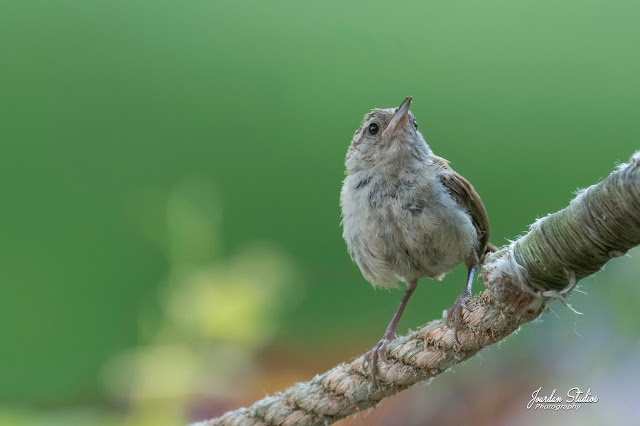Shawangunk Grassland NWR, Pt 2 - 15 Jul 2021
The rains have finally moved to the east and skies began to clear last night. This morning Robin and I had breakfast on the deck blanketed in grape vine and overlooking the Rondout Creek. Visits by a baby Carolina Wren and a baby Gray Catbird was a splendid start to warm, humid morning. Another Bald Eagle flew overhead and roosted in the trees across the river-sized creek. A few minutes later we were joined by an adult catbird singing from the clothes line.
With clearing skies and temperatures soaring to the 90's today it was a good time to go back to Shawangunk Grasslands NWR and look for more photo opps. My boots were still wet so I promised not to hike too far from the car.
I headed out along the Red Trail at the south end of the parking lot that looped south of the viewing platform. With the treeline to my right I headed due east into the rising Sun. Viewing was a bit harsh but not too bad, and I knew that I'd have good light behind me when I returned to the car.
The male Dickcissel continued to sing at the north end of the parking lot, and this time I could see him atop the dead tree that stood lookout over the prairie. Eastern Meadowlarks and Bobolinks were more distant this morning, but a few came close enough to digiscope.
With fewer birds to chase I spent more time photographing the Monarch Butterflies that were working the milkweed plants. Widow Skimmers darted ahead of me as walked the mowed trail.
It was nice to see Chicory blooming in all directions; its one of my favorite summertime wildflowers. Nearby, stands of Big Bluestem were going to seed and obscuring views below six feet tall.
Bumblebees were checking out the Red Clover, but opting for the juicier milkweed plants. Song Sparrows were actively checking me out from their territorial grasses.
I lucked into more Cinnamon (Hummingbird) Clearwings, this time near stands of flowering thistle.
With the prairie in bloom I seemed to be drawn to patches of coneflower that were flowering everywhere.
Tiny Common Ringlet butterflies fluttered like gray, windblown leaves among the Sweet White Clover that sprouted 1-2' off the ground. This little guy cost me three trips through Kaufmann's Field Guide to Butterflies of North America before I finally got a proper ID.
As I continued out into the middle of the grasslands I began to hear (finally) the loud buzzing of Cicadas coming from the bluestem grasses. Sure enough I was able to catch sight of the large bee-sized insects. They vibrated their abdomens against their wings for several seconds, then took off for new perches. I identified these critters as Psaltoda claripennis based on their clean, transparent wings devoid of spots or patterns. I found this guide useful in choosing a best identification.
The walk back brought better light and a Common Yellowthroat singing from the many Big Bluestem perches.
And a beautiful black-phased Tiger Swallowtail.
Cabbage Whites and Clouded Sulphurs were abundant. As were the Common Wood Nymphs that continue to defy capture w/ a lens.
This Common Sootywing was only about the size of my thumb nail! It at least stayed long enough for a photo or two.
This gem of a refuge is worth visiting, and protecting. Especially in the winter time when Short-eared Owls pay a visit. I hope to return someday.
I returned to the car and headed back to the Inn. A Red-tailed Hawk perched on the side of the road was worth a turnaround and a few photos from inside the car.
Shawangunk Grasslands NWR , Ulster, New York, US
Jul 15, 2021 9:00 AM - 11:00 AM
Protocol: Traveling
2.3 mile(s)
Checklist Comments: south portion of red loop; tree-line to south of NWR; sunny; humid; 87F
17 species
Great Blue Heron (Ardea herodias) 2 fly-over pair
Turkey Vulture (Cathartes aura) 1
Northern Flicker (Colaptes auratus) 1
Willow Flycatcher (Empidonax traillii) 1
Barn Swallow (Hirundo rustica) 2
American Robin (Turdus migratorius) 2
Cedar Waxwing (Bombycilla cedrorum) 4
House Sparrow (Passer domesticus) 2
Field Sparrow (Spizella pusilla) 1
Song Sparrow (Melospiza melodia) 6
Bobolink (Dolichonyx oryzivorus) 12
Eastern Meadowlark (Sturnella magna) 2
Red-winged Blackbird (Agelaius phoeniceus) 6
Common Grackle (Quiscalus quiscula) 2
Common Yellowthroat (Geothlypis trichas) 2
Indigo Bunting (Passerina cyanea) 2 Originally suspected immature blue grosbeak seen along south end of NWR along treeline. Flew into view from the tall grasses, got photos, shows thick beak w/ gape of immature bird. Overall brown w/ faint double wingbars, faint blue to tail, chest smudgy gray w/ streaks/spotting typical of juvenile birds. Photographed w/ Sony a1, 200-600mm lens at 600mm, ISO 3200, 1/2000 sec. Heard singing "bzzt" calls before seeing, then heard later from treeline where suspected nesting may have occurred. eBird informed me that it is indeed an Indigo Bunting.
Dickcissel (Spiza americana) 1 Continuing male singing at N end of parking lot in dead tree. Large brown sparrow w/ yellow chest, black chin and singing "Dik-dik-seer-seer". Scoped from parking lot.
View this checklist online at https://ebird.org/checklist/S9
This report was generated automatically by eBird v3 (https://ebird.org/home)










































Comments
Post a Comment
Please leave a comment. I will try to respond ASAP.